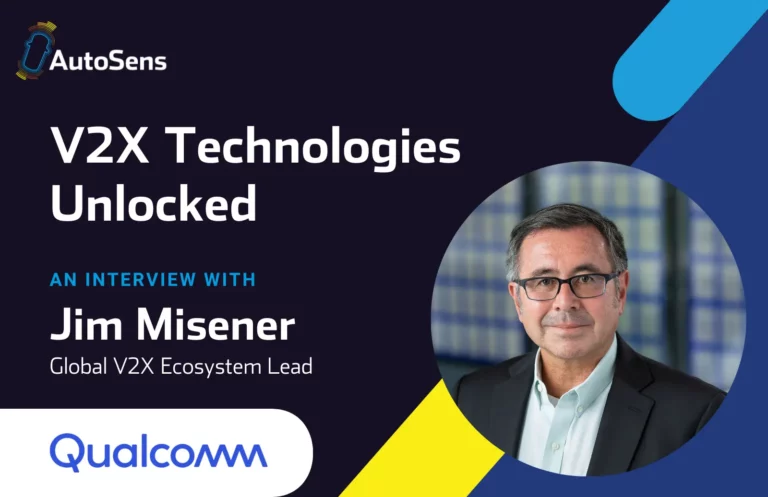
Consultants don’t just seek to give their opinions to earn money. Industry-leading firms must stay ahead of industry trends and anticipate client expectations by constantly reviewing activities inside and alongside a sector to provide robust, reliable guidance. This research might take the shape of statistical studies, technical appraisals or market reports.
Happily for the rest of us, some companies, including SBD, freely provide pared down summaries of this research online, listing some challenging industrial, societal and technical market forecasts to ponder (incidentally, these are also useful presentation fodder if you need to win someone over to a different way of thinking!).
Dr Alain Dunoyer (pictured right), Head of Autonomous Car at SBD, as a special guest speaker at AutoSens, will have a Plenary Session entitled “What’s going on in the ADAS ecosystem?”
We asked to get his views on the industry changes the firm has witnessed, and the future impacts those events could have.
It’s been a busy year for ADAS and autonomous vehicle stakeholders, what do you see as the main highlights?
We have witnessed at least 4 major trends:
- The increased fitment of collision avoidance technologies such as Autonomous Emergency Braking combined with the multiplication of sensor fusion solutions.
- The acceleration of joint-ventures or acquisitions in the sensing and software space to support the deployment of higher levels of vehicle autonomy
- The industry is still split on the next logical step for higher levels of autonomy. Most OEMs are still talking of SAE level 3, but some have now declared their focus on level 4 instead.
- Most companies are struggling to find engineers to support the rapid growth, especially in terms of software development.
Have there been any problems or low-lights that the industry has faced, or struggled with?
In terms of low-lights, the Tesla first fatality under autopilot mode is probably the main one. The investigation is clearly still on-going and we will need to wait for the investigation to be completed to fully understand the potential consequences. What is clear however, is that OEMs cannot ignore the fact that people will either misunderstand, misuse or even abuse higher levels of autonomy.
Such scenarios need to be included in the risk assessment and design solutions need to be implemented to minimize the risks. Relying on consumers to correctly use such systems is not going to be sufficient in the future. OEMs also need to be much clearer in their communication, especially in terms of system capability so that consumers can better understand where, when and how ADAS should be used.
A recent consumer survey that SBD conducted in the USA clearly highlighted that consumers do not know the limitations of their current ADAS and in many cases are overestimating the actual capability.
Dealers will play a critical role as they are the main point of contact with the consumer. Again, SBD’s research showed that they are ill-prepared and in many cases do not understand the different ADAS themselves.
[button link=”#mailmunch-pop-172267″ linktarget=”_blank” color=”blue” size=”medium” style=”flat” fullwidth=”false”] [icons style=”icon-envelope” size=”18px” color=”#ffffff”] Join the AutoSens Mailing List [icons style=”icon-arrow-right” size=”18px” color=”#ffffff”][/button]
There is much uncertainty about the future car industry – What patterns do you see emerging for the future of mobility?
Identifying patterns is still premature. The challenge with mobility is the fact that there is not a unique solution for all. For new mobility solutions to be successful, they need to answer a specific problem. Each city environment would have a different challenge depending on the availability and frequency of existing transportation solutions for example.
Mobility will need to be bespoke to a large extent as needs can be very different depending on personas and circumstances. Living inside the city or in the countryside presents different requirements. Being single or having a family also presents different mobility needs.
What do you think the next generation of vehicle consumers are looking for?
From our own consumer research, we know that existing consumers are not necessarily looking for higher levels of automation. One of the reason being the current system limitations. For example, a very large proportion of ADAS users are switching their systems off for a significant part of their journey. This is the case with systems such as Lane Departure Warning that, depending on the journey type, is perceived as being annoying or not effective.
Existing systems need to be a lot more intelligent so that they get automatically activated as and when needed. This means having a much greater understanding of the conditions outside and inside the car (i.e. driver monitoring).
This is becoming possible through greater system integration and higher levels of sensor fusion. Another interesting aspect is the fact that existing ADAS users are more likely to embrace higher levels of automation, but their focus is more towards greater levels of safety rather than increased comfort and convenience.
Do you think humans driving themselves will become as rare and expensive as flying as a hobby within your lifetime?
I think I am unlikely to witness a time when driving a car is as rare and expensive as piloting a plane during my lifetime. The reality is that it is very difficult to offer a solution as convenient and as cheap as jumping into your car to go where you want at no notice.
We are likely going to see a gradual introduction of highly automated vehicles for specific use cases and in specific areas, such as car sharing solutions. Over time, assuming such schemes are successful, a gradual shift towards new car ownership models may become more prevalent.
[button link=”#mailmunch-pop-172267″ linktarget=”_blank” color=”blue” size=”medium” style=”flat” fullwidth=”false”] [icons style=”icon-envelope” size=”18px” color=”#ffffff”] Join the AutoSens Mailing List [icons style=”icon-arrow-right” size=”18px” color=”#ffffff”][/button]
One aspect to remember is that many of the sensors used for autonomous driving will struggle in bad weather conditions (heavy snow, fog, etc.). Under such weather conditions, people will still need to travel so it would not be acceptable for the mobility solutions to just shut-down and wait for the weather to get better. At least under such scenarios, for the near future people will have to drive themselves.
Driving pleasure should also not be ignored. For many of us driving (outside of traffic jams) is a pleasurable activity and is likely to stay for many years to come.
From a technical perspective, what do you think are the disruptive technologies that will shake up this sector (in addition to lower cost LiDAR)?
Artificial Intelligence has made some great progress in recent years, mainly due to the availability of more powerful and affordable hardware solutions. The software solutions are not necessarily new, they are just now possible within the automotive constraints of cost, power consumption and packaging.
This has given the ability to many players outside of the conventional automotive industry to rapidly demonstrate some capability in terms of object detection, free space identification and path planning. However, one of the main difficulties is the ability to validate such solutions. At the moment there is no straight forward way to demonstrate the robustness of such solutions. This is a real difficulty as the consequences could be serious if for example an accident was to be caused by employing such techniques.
Find out more
We will be delving deeper into all of these areas and a host of extra content at the AutoSens conference, held in September 2016 at AutoWorld in Brussels, Belgium.
Carefully selected experts will discuss the shared challenges, innovation, standardisation and supply chain collaboration involved with the development of the latest ADAS technologies and self-driving cars via panels, presentations and conversations.
[button link=”#mailmunch-pop-172267″ linktarget=”_blank” color=”blue” size=”medium” style=”flat” fullwidth=”false”] [icons style=”icon-envelope” size=”18px” color=”#ffffff”] Join the AutoSens Mailing List [icons style=”icon-arrow-right” size=”18px” color=”#ffffff”][/button]
About SBD
SBD are specialists in automotive technology, providing independent research and strategic support to the world’s leading car manufacturers and suppliers. Find out more at sbdautomotive.com







